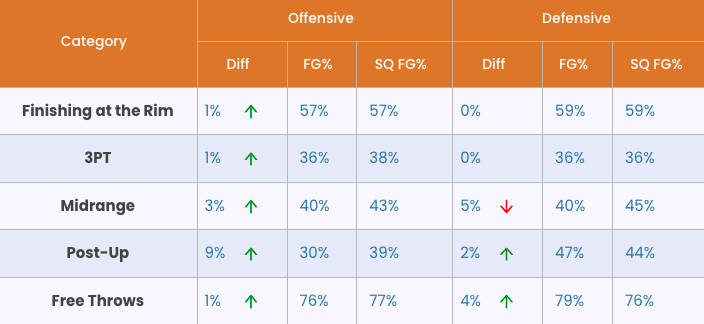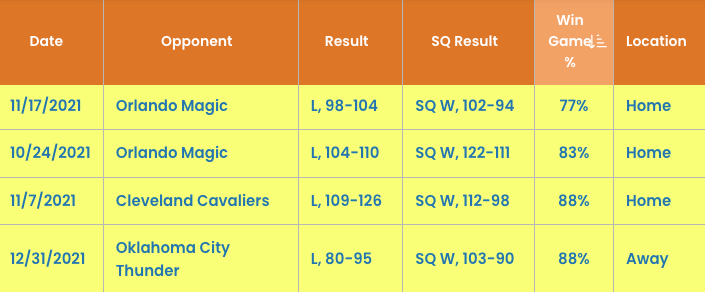A look at the Knicks’ offensive process using ShotQuality
The Knicks seem to have had some rough luck in 2021-22, with good looks not falling and opponents going nuclear for no reason. What does the data from ShotQuality tell us about how things have gone for the Knicks so far this year?
The NBA is, and always has been, a “make or miss” league. It’s a truism that is testament to the fundamental appeal of not knowing what will happen in any given game, where great shots can rim out and terrible shots can drop; where Ricky Rubio can shoot like Steph Curry and Steph Curry can shoot like Brad Wanamaker; where anyone can, on any random Wednesday night, beat anyone. This volatile unknown is the nectar of sports’ essential draw, but it can also bend the truth, that over the course of a single game or even a whole season — the ball does, sometimes, lie.
Whether a shot is made or missed is the exact pinpoint tip of an iceberg of information, no more than the box score result of a possession that involved a shot, but the result alone is fickle justification for labeling the look a good or bad one. The bulk of the iceberg’s useful mass is in the process of the shot, not the result.
Stop me if you’ve felt the surge of primal injustice that accompanies this common offensive sequence watching the 19-21 New York Knicks this season.
A player wearing blue and orange leverages a hard-earned half-court slither of an advantage and breaks through the defenses perimeter lines, they get their toes in the paint, sense the human-squash of a collapsing defense, and flick over the first domino, kicking the ball out to an open shooter. Defenders scramble and rotate to challenge the shot and the ball is swung to another open Knick. The same split second sequence is repeated: scramble, rotate, swing. After one kick and two swings, there are no more rotating defenders, and one of the good guys has time to check the wind twice before launching a shot that may as well be a warmup.
They miss. Groans echo around the Garden. Not this song again.
This season, it sure feels like they’ve missed a lot of these good-process, bad-result type shots, and that feeling may have some legs.
ShotQuality is a metric that evaluates a teams performance according to the expected value of each shot, a value that is calculated using over 90 variables — including who’s shooting and where they’re shooting from, who’s defending and how far they are from contesting the shot, how long was left on the shot clock, the chance of an offensive rebound, and many, many more — to capture a picture of the true quality of every shot; a picture that prioritizes process over the volatility of make or miss results.
I asked Simon, the founder of ShotQuality, how his metric evaluates the Knicks performance so far this season:
“The Knicks currently rank 16th in offensive shot quality and 13th in defensive shot quality, which, despite the drop-off in record, is actually a significant improvement on last season. Last year in net ShotQuality, the Knicks ranked 25th in the NBA, and this year they’re 14th. Last year, a major reason for them being 25th was because opponents shot 3% lower than expected on 3-point looks. The Knicks have also gone from 24th to 12th in combined rim and 3-point shot frequency on offense, showing a significant evolution from some of their analytically antiquated shot profiles of the past, by eliminating a lot of midrange looks, and shooting more threes generally, but mostly off the bounce.”
This year, opponents are shooting more in line with what SQ’s model would expect, which has contributed to the defensive drop-off so far this season, but the big difference can be seen offensively, where the Knicks are underperforming their expected percentages from all five spots on the floor.
Here’s the Knicks’ regression analysis from this season:
Compared to their regression analysis from last season:
One interesting number that has stayed the same across both campaigns is the Knicks’ SQ (i.e expected) 3P%, which has held firm at 38% despite the Knicks bringing in more shooters and taking more threes. As Simon references above, this is likely due to the type of triples the Knicks are taking. Last year, 9% of the Knicks’ shots were off-the-dribble threes, a number that this year has ballooned to 17%, the second most in the league. Although the Knicks expected points per possession on these pull-ups is a nice 1.06, good for ninth in the league, it is still a tough shot, and much less efficient than a catch-and-shoot look. Off the catch, the Knicks’ expected efficiency is 1.17 points per possession, again good for ninth in the league, but they are just 24th in attempt frequency.
Generating a few more catch-and-shoot threes would raise the Knicks’ offensive ceiling and floor, because it’s a more efficient, and less volatile shot than its off-the-dribble cousin.
Over the course of the season, there are always going to be games that feel like they went the wrong way. ShotQuality helpfully breaks down the ones most likely to challenge the average fan’s sphincteral control. Some of the more lopsided results, in both directions, may not come as much of a surprise.
Here are a few of the games where the Knicks have gotten a little lucky:
Here are a few of the all too memorable games — who could forget the Ricky Curry experience — where the Knicks got the short end of the stick:
And here are the surprisingly easy on the eyes ShotQuality expected Eastern Conference standings so far:
ShotQuality has the Knicks’ expected record this season at 21-19, giving them a two game bump on reality, which would be good for seventh place in the East. This doesn’t sound like much, and underscores the fine margins in the sardine-tin middle of the suddenly superior Eastern Conference, but would likely flip the perception of this season as some unequivocal failure on its head. This perception would take an even bigger hit when factoring last season’s ShotQuality expected record of 29-48, with a by-far league-worst drop in actual to expected win percentage of -16.88%.
This is the brain-knotting crux of attempting to evaluate this Knicks season: they’re not only experiencing make-and-miss volatility within this campaign, but experiencing it in the mountainous shadow of a season where they were on the exact opposite side of the same volatile coin. Last season’s hot hand has made this season’s cold stretch feel far colder than it actually is, heightening the hangover, something like going from a sauna to an ice bath — which is disorientating and painful and may explain a profanity or two. In the Mecca, apparently, the ball has decided on a Jekyll-meets-Hyde-meets-Pinocchio impression as a source of pandemic amusement.
Which is not to say that the Knicks aren’t playing badly this season, or that they didn’t play well last season; but that this stuff is messy, and placing a too-confident digit on anything is dicey. Tools like ShotQuality are trying to clean up some of this mess, where once “make or miss” was a mythical conversation killer that bowed to the authority of a ball’s bounce and a rim’s whim, now it’s a conversation starter: we have a result, let’s see if the process checks out.
For this team, the evaluative waters are clouded, simultaneously, with the champagne of last season, and the tears of all the seasons before that: a gloopy and congealed emotional cocktail of expectations. Competence where there was none, like hope where there was none, can be a dangerous thing. But there are reasons to believe in whispers that things this season may not be quite as bad as they seem, especially if we remember that they probably weren’t ever quite as good as it felt like they were last season either.
In a way, the Knicks of the last two years have been a perfect poster for the long-nosed unknown of makes and misses; last season as the tough shot that drops; this season — so far at least — as the better shot that just rims out.
All tables and stats are taken directly from the ShotQuality website, which I highly recommend as a treasure trove of interesting statistics. An annual subscription for Knicks-only statistics is available for a very reasonable $29.95. Hours will disappear, you have been warned!







